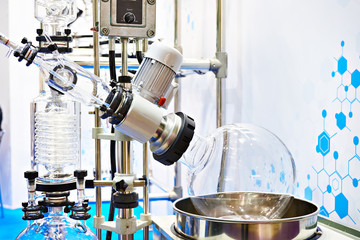A rotary evaporator is a laboratory instrument used to remove or recover solvents at low pressure, thus allowing the extraction of compounds in a more efficient way than with the usual distillation-condensation systems.
This equipment is used to evaporate substances through the distillation process, then be condensed and finally separated into its components one by one, this thanks to its specific boiling points. Due to all the benefits of purchasing this instrument, many laboratories currently have one.
Structure of a rotary evaporator
A rotary evaporator has an electric motor that causes the rotation of a tube attached to a frosted glass joint guide tube. The latter has attached to its structure a round-bottomed flask containing the solution. Maintaining a rotating motion, this flask is partially submerged in water. In the system there is a coolant that circulates a liquid (water or antifreeze), this generates the condensation of the solvent, which is recovered in a collector. Its components include:
- A round flask to collect the distilled material.
- A vacuum equipment to reduce the internal pressure of the equipment.
- A height adjustable column and a spiral-shaped condensation column.
- An adjustable heating unit.
- A second round flask for evaporation.
- A pedestal for the rotation motor.
How does a rotary evaporator work?
Rotavaporators are used for the soft removal of solvents by evaporation. These equipment are much more efficient than simple distillation equipment, thanks to the fact that it is possible to attach a vacuum system that reduces pressure. When generating sample rotation, the contact area is larger and therefore evaporation occurs much faster. In addition, it has a controlled heating system that also makes the chemical process more efficient.
In a rotary evaporator the sample to be processed is placed in the separating flask, which is immersed in the water, and then the heat-regulated bath and rotation system is ignited, then by the action of the vacuum pump, the pressure is lowered, causing the solvents to be separated from the solutes, and these solvents are distilled in the condensing tube at low temperature and collected in the flask intended for this purpose.
Applications of rotary evaporators
Rotavaporators are used in processes of evaporation, distillation, separation of chemical components, drying, extraction, recovery and quantification of fragrances, natural extracts, among others, in the chemical industry, pharmaceutical industry, or in research laboratories. Among its main applications according to the specific area, we have:
- Pharmaceutical industry: different applications in quality control and laboratory formulas, among their uses we have in distillation, concentration and drying processes.
- Chemical industry: they are used in everyday applications of chemical and quality control laboratories for processes such as concentration, reflux reaction, and recrystallization.
- Academic Sector: they are very useful for a wide range of applications in academic training in complete evaporation processes.
- Food and beverages: they are used for quality control purposes in the food and beverage sector, as well as in the development of new ingredients and product components, through processes such as distillation, concentration and drying.
- Environmental analysis: it is necessary in the preparation of samples for the control of environmental pollution through soxhlet extraction and concentration.
What do we offer you in Kalstein?
At Kalstein we are a company MANUFACTURER of laboratory equipment of the highest quality and the best technology at the best prices in the market, so you can make your purchase confidently, knowing that you have the service of a firm and committed to innovation. This time we present our Rotary Evaporator YR02307, which has the following characteristics: it has a large capacity flask and a large opening that provides a greater evaporation surface. The evaporative flask continues to spin when constantly heated by a water bath, and the solvent evaporates more efficiently under vacuum conditions. It can be used for pilot-scale production in biological engineering, pharmaceutical industry, chemical industry and food processing. It usually works with water circulation vacuum pump, diaphragm vacuum pump, recirculation cooler, constant temperature circulator, low temperature circulation pump, among its advantages we can mention: HERE
- Patented double sealing technology of Teflon (PTFE) and FV rubber ensures negative pressure level.
- Automatic switching valve makes continuous collection possible without affecting the vacuum degree and without stopping distillation
- Teflon relief valve is corrosion-resistant and pollution-free
- Water bath jacket that protects the operator from burns by hot liquid.
For more information, please check out: HERE

